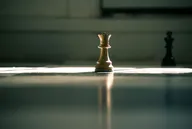Chess and Creativity: ingenuity in the shadows
Defense is not just resistance; it’s a refined form of creativity. Few players embodied this concept like Tigran Petrosian , World Champion from 1963 to 1969. Influenced by Capablanca and Nimzowitsch, he developed a unique positional and maneuvering style capable of neutralizing even the sharpest attacks. He represented an independent school of thought, capable of embracing old theoretical teachings while exploring new paths.
I used to sleep with My System under my pillow.
Petrosian’s Journey
In 1963, at the peak of his chess career, Petrosian defeated Botvinnik 12.5 to 9.5. His style was distinct: he didn’t seek immediate dynamic advantages but built positions where events unfolded slowly. At the heart of it was his revolutionary idea: the relative value of pieces matters more than material count.
Petrosian had a very peculiar chess talent. Like Tal, he did not try to play according to position in the traditional sense. But while Tal strived to obtain dynamic positions, Petrosian built positions where events unfolded in slow motion.
Notable Games
Notable games from 1953 showcase Petrosian’s mastery of the exchange sacrifice, his signature weapon. In Reshevsky-Petrosian, he found a brilliant defensive resource, sacrificing a rook for a bishop to neutralize his opponent’s attack and secure the position. In Troianescu-Petrosian, his deep strategic understanding led him to a different kind of exchange sacrifice, crafting a long-term winning plan from an apparently equal position. These games demonstrate how Petrosian could transform seemingly passive positions into strategic masterpieces, finding hidden resources in quiet positions through his favorite tactical theme: the exchange sacrifice.
Types of Positional Sacrifices
Petrosian’s creativity lies in his unique ability to use positional sacrifice to achieve long-term strategic advantages. This mastery manifested in several forms:
- 🔐 Preventive: neutralizes a threat or idea before it becomes critical.
- 🏠 Positional: gains control of key squares or limits opponent’s activity.
- ⚡ Tactical: triggers initiative or sets up a direct attack.
Suggested readings
- “The Exchange Sacrifice” by Vassilios Kotronias
- “Python Strategy” by Tigran Petrosian
Conclusion
Petrosian proved that silent ingenuity can shine. His defensive approach, rooted in patience, deep understanding, and long-term planning, invites us to rethink creativity: not just attack and brilliance, but also subtle control, restraint, and strategic finesse.
Alberto
Related Posts

The N-Queens Puzzle: A Journey Through Logic and Programming
The N-Queens puzzle is a classic problem of logic and programming that has fascinated chess lovers

Chess and Creativity: artificial intelligence
Artificial intelligence has redefined chess, introducing new ideas and strategies

Chess and Creativity: flexibility in structures
Pawn structures are not merely static setups: they represent the DNA of a position.